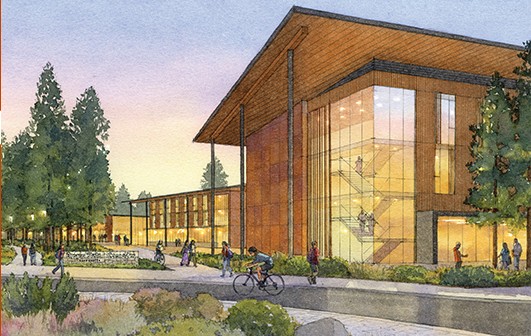Since 2011 Oregon State University and OSU-Cascade campus leaders have shared their vision for a future campus within the community of Bend. The process to determine the location has been inclusive and thorough as they investigated numerous site options. The site selection was aided by committee of Central Oregon’s leading real estate experts (Mike Hollern, John James, Kirk Schueler, Bill Smith and Todd Taylor) who confidentially advised campus leaders on market, price, land preparation and timing.
A 17-month collaborative effort of the Campus Expansion Advisory Committee engaged 108 individuals including community members, neighborhood association representatives, architects, planners, healthcare professionals, non-profit leaders, business leaders, local and state government representatives, and educators – who worked with the advisory committee and its task forces, resulting in 115 recommendations plus guiding principles addressing healthcare, housing, neighborhood livability, regional collaboration, sustainability and transportation.
The public was offered numerous opportunities to review the sites and the decisive recommendation from the site selection committee. Ultimately the Bend City Council approved the site on June 3, 2014 and the hearings officer upheld that decision on September 2. The City Council’s written decision on October 15 was a third decision in favor of the application.
The selected property and its adjoining parcels is the only large acreage parcel available within the Urban Growth Boundary with services to the site. It’s an appealing site that will attract and retain students and faculty leading to the long-term success of the campus.
Despite the overwhelming support for the site throughout the community an opposition group has appealed the decision through Oregon’s land use process. Although they have the legal right to file an appeal they have been holding up a land use decision with tedious and unnecessary complaints about the table contents and the layout of the documents presented to the land use board.
The appeal levels at the state allow for several appeal stages, leading to costly delays and legal fees to OSU-Cascades in spite of decisions in favor of the site application by the City of Bend. It can take time to work through appeal stages.
The goal to open the new 10-acre campus in fall 2016 remains strong. The end goal is to support Oregon’s educational attainment levels to create more successful communities, Central Oregon’s 30-year effort to establish a four-year university campus and the vision for a campus that is integrated into the community.
A campus that is incorporated into the City provides maximum operating and financial efficiencies, leveraging surrounding community amenities such as restaurants, shopping, medical centers and recreation facilities. The choice might be said to be between an environmental friendly community-based urban campus on the 10 acres or a shopping center (which the acreage is zoned to allow).
The vision of this new campus and the community’s desire for the site resulted in a $1 million community fundraising effort to gain support from the Oregon University System to expand to a four-year campus and a historic $4.6 million philanthropic match to state funds totaling $16 million.
OSU-Cascades is proactively working with the community to plan for mitigation of any negative impacts a university will have – from traffic to neighborhood livability. It intends to create a campus that establishes a new paradigm in transportation for universities and for Central Oregon, including a broad range of transportation options and shorter trips. OSU-Cascades’ goal is to support sustainable transportation choices and minimize parking demands by de-emphasizing single-occupancy motor vehicle use and incentivizing other options.
As elected officials who generally have supported the OSU-Cascade campus it is imperative that you continue to support and assist in helping to move the process along whenever possible. Bend’s economic vitality and ability to attract and retain qualified workers is at stake.





2 Comments
I ma not a member of the Truth In Site group and I am not a NIMBY. I think the site chosen for the OSU Cascades Campus is idiotic and will prove in the long run to have been a mistake.
I am not a member of TIS nor am I a NIMBY either. To quote this article, “The public was offered numerous opportunities to review the sites and the decisive recommendation from the site selection committee.” This is just not true. The facts are, the public was informed of the decision after the site was selected and after letters of intent to purchase were completed. I was one of a chosen few to learn of the decision after OSU had made a financial committment to purchase the land. The article goes on to say, ” Ultimately the Bend City Council approved the site on June 3, 2014 and the hearings officer upheld that decision on September 2. The City Council’s written decision on October 15 was a third decision in favor of the application.” This likewise is questionable reporting. These two decisions were solely to determine if the OSU-Cascades application was in compliance with the Bend Development Code. Both decisions were silent on support or non-support for the OSU-Casacades application.
The article goes on to say, “The selected property and its adjoining parcels is the only large acreage parcel available within the Urban Growth Boundary with services to the site.” Key words are “with services to the site” which conveniently rules out Juniper Ridge representing large acreage, room for long term expansion and envisioned as a site for higher education by the City and the Community without livability issues for surrounding landowners.
Why was (is) the 46 acre pumice mine and adjacent Deschutes County demolition landfill site not developed when most other land within the UGB is developed or has plans for development? Does this not set off a loud siren? Did the “Committee” led by John James find a solution to land with issues and no future?